
The ferry left Osaka at noon. This would be our second international passage by ship, sailing from Osaka, Japan to Shanghai, China. Having crossed the Pacific by container ship, we felt prepared for the two-day voyage.
 ROOMS: Our rooms were dingier than I expected, with the only window looking right onto a busy deck. The shared bathrooms were close by, a curse and a blessing. When we had booked our tickets four months ago, we had felt that second class lodgings would be sufficient; each cabin had four berths and a small common space with a TV. The overall living situation was very dorm-like. Third class consisted of two big halls, separated by sex, with tatami mats and futons for the women and carpet with futons for men. The two third class rooms were large, airy, and well lit, and if I were traveling by myself, I would have picked this option. While we longed to make contact with the locals, we were glad no one else showed up to occupy the other two berths in our room. The next day, a small cockroach appeared, making me wish for the joys money can buy (though there was no guarantee the little fellow wouldn't have found us in first class as well).
ROOMS: Our rooms were dingier than I expected, with the only window looking right onto a busy deck. The shared bathrooms were close by, a curse and a blessing. When we had booked our tickets four months ago, we had felt that second class lodgings would be sufficient; each cabin had four berths and a small common space with a TV. The overall living situation was very dorm-like. Third class consisted of two big halls, separated by sex, with tatami mats and futons for the women and carpet with futons for men. The two third class rooms were large, airy, and well lit, and if I were traveling by myself, I would have picked this option. While we longed to make contact with the locals, we were glad no one else showed up to occupy the other two berths in our room. The next day, a small cockroach appeared, making me wish for the joys money can buy (though there was no guarantee the little fellow wouldn't have found us in first class as well).
 PACE: The ferry would take a little over 48 hours to get to China. I couldn't help but compare this to what flying might have been like. We would probably have made a mad rush to the airport on the edge of town, endured senseless immigration and security procedures, breathed recyled air, eaten bad plane food, and been nagged by the general feeling of just wanting to be there already. I like getting there too, but on this journey I didn't envy travelers arriving in Shanghai in 4 hours instead of 48, with no time to reflect on what they were leaving and what they were about to experience.
PACE: The ferry would take a little over 48 hours to get to China. I couldn't help but compare this to what flying might have been like. We would probably have made a mad rush to the airport on the edge of town, endured senseless immigration and security procedures, breathed recyled air, eaten bad plane food, and been nagged by the general feeling of just wanting to be there already. I like getting there too, but on this journey I didn't envy travelers arriving in Shanghai in 4 hours instead of 48, with no time to reflect on what they were leaving and what they were about to experience.
 PASSENGERS: There were only about 30 passengers on board and about 10 staff. I tried to learn some Chinese phrases but I still kept speaking in pidgin Japanese to the trilingual Chinese crew; I'm sure they wished that I would just speak in English. We soon became familiar with the faces of the people on the ferry. We spoke to other travelers like ourselves, exchanging stories of our countries and travels. We had heard that the ferry was used by Chinese immigrants to Japan, to visit China. We met an older gentleman whose parents were Chinese and had moved to Japan. He was born there and continued to live in Yokohama. His wife was also born of Chinese parents in Japan. He had taken this journey a few times, the earliest voyage about forty years ago, when the ferry did not pull into harbor, but instead passengers were transferred from boat to shore in small boats. We shared our photos of traveling on the container ship over the Pacific and he brought his wife back to look at the pictures. Our fellow passengers were people wanting to experience the romance of traveling by sea, older folks with time on their hands reliving nostalgic memories, groups of friends taking the journey together, and others who took the boat for the practical reason that they could carry more things with them between Japan and China.
PASSENGERS: There were only about 30 passengers on board and about 10 staff. I tried to learn some Chinese phrases but I still kept speaking in pidgin Japanese to the trilingual Chinese crew; I'm sure they wished that I would just speak in English. We soon became familiar with the faces of the people on the ferry. We spoke to other travelers like ourselves, exchanging stories of our countries and travels. We had heard that the ferry was used by Chinese immigrants to Japan, to visit China. We met an older gentleman whose parents were Chinese and had moved to Japan. He was born there and continued to live in Yokohama. His wife was also born of Chinese parents in Japan. He had taken this journey a few times, the earliest voyage about forty years ago, when the ferry did not pull into harbor, but instead passengers were transferred from boat to shore in small boats. We shared our photos of traveling on the container ship over the Pacific and he brought his wife back to look at the pictures. Our fellow passengers were people wanting to experience the romance of traveling by sea, older folks with time on their hands reliving nostalgic memories, groups of friends taking the journey together, and others who took the boat for the practical reason that they could carry more things with them between Japan and China.
 LIFE ON-BOARD: The general atmosphere on the boat was lively. People chatted and made friends with the crew and other passengers.Action movies played on the TVs in common areas, speaking the universal language of violence, needing no translation. In the evenings after dinner, karaoke tunes wafted into the common spaces.We spent time in the reading room when we wanted some quiet. Water and hot tea flowed freely from a dispenser, and vending machines sold ramen, beer and sweet coffee. The food on board was delicious and cheap. We had watermelon for dessert everyday for less than a dollar. Anirvan discovered the joys of cold bean curd skin and I was amazed by how delicious tofu could be--soft, silky, melt-in-your-mouth.
LIFE ON-BOARD: The general atmosphere on the boat was lively. People chatted and made friends with the crew and other passengers.Action movies played on the TVs in common areas, speaking the universal language of violence, needing no translation. In the evenings after dinner, karaoke tunes wafted into the common spaces.We spent time in the reading room when we wanted some quiet. Water and hot tea flowed freely from a dispenser, and vending machines sold ramen, beer and sweet coffee. The food on board was delicious and cheap. We had watermelon for dessert everyday for less than a dollar. Anirvan discovered the joys of cold bean curd skin and I was amazed by how delicious tofu could be--soft, silky, melt-in-your-mouth.

ARRIVAL: As we were leaving Japan, we couldn't help but notice trash in water. We'd sometimes been shocked to find orange swirls outside Japanese waters, which, though lovely to photograph, were probably chemical spills.But none of this prepared us for the water turning a muddy brown as we approached the constantly developing shores of Shanghai. It took more than two hours along the river to reach the ferry building. We watched the floating scenery of boats carrying building materials, and other boats big and small whose purpose was not obvious to us. As Shanghai drew nearer, the brown of the waters, though still existent and omnipresent, seemed like a distant memory as our eyes soared to behold the famed Pudong skyline and the new ferry building. Welcome to China.
Related slideshow: Duo Lun Street's markets and art, Museum magic in Shanghai
Next post: Climate activism in Vietnam

Love reading your posts as I travel in India. Sadly, that haze in the air and mysterious swirls in the water look all too familiar.
Keep the posts coming; you're making me nice and envious of your travels. It really makes me want to strap the backpack on again.
Also thanks, from all of us (Bryan, Shauna, Tatiana, and myself) for the postcard, it was very well received!
Take lots of Vietnam photos for me and try and eat your weight in Phở while you are there.
Stumbled across your story while doing research for a book. It is very inspirational. My girlfriend and I are now considering a trip on a cargo ship. We already choose trains over planes when traveling over land. Keep the reports coming!